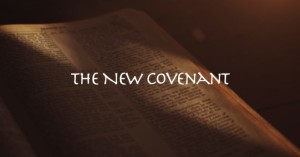THE CHURCH AND THE NEW COVENANT
IN SAYING ‘NEW,’ THE WRITER OF THE BOOK OF HEBREWS HAS DECLARED THE FIRST (COVENANT) OLD; now the thing declared old and becoming obsolete (is) our vanishing. (8:13),
NAS Hebrews 8:13 When He said, “A new covenant,” He has made the first obsolete. But whatever is becoming obsolete and growing old is ready to disappear.
A CONCLUSION IS NOW DRAWN FROM THE TERMINOLOGY OF THE JEREMIAH PASSAGE. When God called the covenant which He proposed to make with Israel a new covenant (8:8; cf Jer. 31:31), He implied that the first covenant (the one given at Sinai) was old. Our author then elaborates on this concept by the reasoning of what is old and obsolescent is doomed to eventual destruction. Hence the thought of replacing the first covenant with a second should not seem strange. This is all the more understandable when it is recognized that the first covenant was implied as “old” around 600 B.C. (i.e., the time of Jeremiah). Surely the readers of Hebrews should not feel uneasy at the thought of the former economy being superseded.
THE CHURCH AND THE NEW COVENANT
A CRUCIAL QUESTION IS THE IDENTITY OF THE BENEFICIARIES OF THE NEW COVENANT. WHO FULFILLS IT? HAS IT BEEN FULFILLED? Suggestions are many, and whatever explanation one adopts reflects something of his hermeneutics as well as his general theological regarding eschatology.
THE EXPRESSION THE ‘NEW COVENANT’ OCCURS SIX TIMES IN THE NEW TESTAMENT.
Likewise, also the cup after supper, saying, This cup is the new testament in my blood, which is shed for you (Luke22:20).
After the same manner also he took the cup, when he had supped, saying, This cup is the new testament in my blood: this do ye, as oft as ye drink it, in remembrance of me (1Cor.11:25). Who also hath made us able ministers of the new testament; not of the letter, but of the spirit: for the letter killeth, but the spirit giveth life: (2 Cor. 3-6).
For finding fault with them, he saith, Behold, the days come, saith the Lord, when I will make a new covenant with the house of Israel and with the house of Judah (Heb.8:8).
And for this cause, he is a mediator of the new testament, that by means of death, for the redemption of the transgressions that were under the first testament, they which are called might receive the promise of eternal inheritance (Heb. 9:15).
And to Jesus the mediator of the new covenant and to the blood of sprinkling, that speaketh better things than that of Abel (Heb. 12:24).
SEVERAL OTHER NEW TESTAMENT PASSAGES, SOME OF THEM IN THE SAME CONTEXT WITH THE ABOVE, USE THE WORD ‘COVENANT’ ALONE AND PRESUMABLY ARE REFERENCES ALSO TO THE NEW COVENANT (Matt. 26-28; Mark 14-24; Rom. 11:27; Heb. 8-10, 13:9:15b; and 10:16). It should be noted in passing that the word “new” in the Hebrews 12:24 reference is different from the one used in all the others.
FOUR VIEWS ARE CURRENT TODAY REGARDING THE RELATIONSHIP OF THE CHURCH TO THE NEW COVENANT:
VIEW 1. THE CHURCH HAS REPLACED ISRAEL AS THE PARTICIPANT IN THE NEW COVENANT. This is the viewpoint of amillennialists, who see the nation of Israel as permanently displaced and all the blessing promised to her now fulfilled by the church. Lenski is representative of his position as he writes concerning the mention of “the house of Israel” in Hebrews 8:8:
“Right here we have the universality of the new testament. Lost among the Gentiles and turned Gentile, the gospel goes out to all nations to bring the new testament in Christ’s blood to all.”
Oswald T. Allis comments in the same vein regarding the new covenant:
The passage speaks of the new covenant, It declares that this new covenant has been already old” an introduced and that by virtue of the fact that it is called “new” it has made the one which is replacing “old” and that the old is about to vanish away. It would be hard to find a clearer reference to the gospel again in the Old Testament that in these verses in Jeremiah.
ONE ACCEPTS THIS VIEW ONLY TO THE EXTENT THAT HE IS WILLING TO INTERPRET “THE HOUSE OF ISRAEL AND THE HOUSE OF JUDAH” AS THE CHRISTIAN CHURCH IN THE PRESENT AGE.
VIEW 2. THE NEW COVENANT IS WITH THE NATION OF ISRAEL ONLY. THIS VIEW IS ONE OF SEVERAL VIEWS SUGGESTED BY VARIOUS DISPENSATIONAL PREMILLENILISTS. IT INTERPRETS THE WORDS OF JEREMIAH LITERALLY AND SEES NO WARRANT FOR INCLUSION OF THE NEW TESTAMENT CHURCH.
J.N. DARBY HAS WRITTEN: THE FIRST COVENANT WAS MADE WITH ISRAEL; THE SECOND MUST BE SO LIKEWISE, ACCORDING TO THE PROPHECY OF JEREMIAH… WE ENJOY INDEED ALL THE ESSENTIAL PRIVILEGES OF THE NEW COVENANT, ITS FOUNDATION. LAID ON GOD’S PART IN THE BLOOD OF CHRIST, BUT WE DO SO IN SPIRIT, NOT ACCORDING TO THE LETTER.
THE NEW COVENANT WILL BE ESTABLISHED FORMALLY WITH ISRAEL IN THE MILLENNIUM.
THE TWO VIEWS ABOVE REPRESENT THE EXTREMES – ONE SEEING THE CHURCH EXCLUSIVELY IN THE NEW COVENANT, AND THE OTHER SEEING ISRAEL ONLY.
AS I HAVE ALLUDED TO AND WRITTEN IN RECENT BLOGS, IT WAS THIS DISPENSATIONAL VIEW THAT MOST ACCURATELY DESCRIBES MY THEOLOGY FOR MOST OF THE PAST 25 YEARS, A THEOLOGY OF WHICH I HAVE NOT COMPLETELY REJECTED IN SPITE OF HAVING GROWING MISGIVINGS.
VIEW 3. THERE ARE TWO NEW COVENANTS, ONE WITH ISRAEL AND ONE WITH THE NEW TESTAMENT CHURCH. This explanation recognizes the demands of a strict grammatico-historico – for the Jeremiah passage, and at the same time ACKNOWLEDGES THAT SOME OF THE NEW TESTAMENT PASSAGES CANNOT IGNORE THE CHURCH’S RELATION TO THE NEW COVENANT.
VERY KEY LINE, I BELIEVE: ‘SOME OF THE NEW TESTAMENT PASSAGES CANNOT IGNORE THE CHURCH’S RELATION TO THE NEW COVENANT.’
THIS VIEW WAS EXPRESSED BY CHAFER AS FOLLOWS:
REFERENCE AT THIS POINT IS TO BE MADE WITH ISRAEL AND NOT TO THE NEW COVENANT NOW IN FORCE IN THE CHURCH.
THERE REMAINS TO BE RECOGNIZED A HEAVENLY COVENANT FOR THE HEAVENLY PEOPLE, WHICH IS STYLED LIKE THE PRECEDING ONE FOR ISRAEL A ‘NEW COVENANT.’ IT IS MADE IN THE BLOOD OF CHRIST (cf. Mark 14:24) AND CONTINUES TO EFFECT THROUGHOUT THIS AGE, WHEREAS THE NEW COVENANT MADE WITH ISRAEL HAPPENS TO BE FUTURE IN ITS APPLICATION.
TO SUPPOSE THAT THESE TWO COVENANTS – ONE FOR ISRAEL AND ONE FOR THE CHURCH – ARE THE SAME IS TO ASSUME THAT THERE IS A LATITUDE OF COMMON INTEREST BETWEEN GOD’S PURPOSE FOR ISRAEL AND HIS PURPOSE FOR THE CHURCH.
AMONG OTHERS HOLDING THIS VIEW ARE C. C. RYRIE AND J. F. WALVOORD. J. D. PENTECOST PRESENTS THE POSITION AT SOME LENGTH BUT DOES NOT INDICATE CATEGORICALLY HIS PERSONAL COMMITMENT. THESE THREE WERE ALL STUDENTS OF L. S. CHAFER.
By this view one is required to differentiate among the New Testament references those referring to the new covenant promised to Israel from those describing the new covenant with the church.
VIEW 4. THERE IS ONE NEW COVENANT TO BE FULFILLED ESCHATOLICALLY WITH ISRAEL, BUT PARTICIPATED IN SOTERIOLOGICALLY BY THE CHURCH TODAY.
THIS VIEW RECOGNIZES THAT CHRIST’S DEATH PROVIDED THE BASIS FIR INSTITUTING THE NEW COVENANT AND ALSO ACCEPTS THE UNCONSTITUTIONAL CHARACTER OF JEREMIAH’S PROPHECY WHICH LEAVES NO ROOM FOR ISRAEL’S FORFEITURE.
AT THE SAME TIME IT ALSO NOTES THAT THE NEW TESTAMENT PASSAGES DEFINITELY RELATE NEW TESTAMENT CHRISTIANS TO THIS COVENANT. PERHAPS THE BEST KNOWN REPRESENTATIVE OF THIS POSITION IS THE SCOFIELD REFERENCE BIBLE. AT HEBREWS 8:8 (NAS Hebrews 8:8 For finding fault with them, He says, “Behold, days are coming, says the Lord, When I will effect a new covenant With the house of Israel and with the house of Judah;) THE FOLLOWING NOTES APPEAR:
THE NEW COVENANT SECURES THE PERSONAL REVELATION OF THE LORD TO EVERY BELIEVER… AND SECURES THE PERPETUITY, FUTURE CONVERSION, AND BLESSING OF ISRAEL.
THE NEW COVENANT RESTS UPON THE SACRIFICE OF CHRIST AND SECURES THE ETERNAL BLESSEDNESS UNDER THE ABRAHAMIC COVENANT (GAL 3:13-29), OF ALL WHO BELIEVE…
13 Christ redeemed us from the curse of the Law, having become a curse for us– for it is written, “Cursed is everyone who hangs on a tree “–
14 in order that in Christ Jesus the blessing of Abraham might come to the Gentiles, so that we might receive the promise of the Spirit through faith.
15 Brethren, I speak in terms of human relations: even though it is only a man’s covenant, yet when it has been ratified, no one sets it aside or adds conditions to it.
16 Now the promises were spoken to Abraham and to his seed. He does not say, “And to seeds,” as referring to many, but rather to one, “And to your seed,” that is, Christ.
17 What I am saying is this: the Law, which came four hundred and thirty years later, does not invalidate a covenant previously ratified by God, so as to nullify the promise.
18 For if the inheritance is based on law, it is no longer based on a promise; but God has granted it to Abraham by means of a promise.
19 Why the Law then? It was added because of transgressions, having been ordained through angels by the agency of a mediator, until the seed should come to whom the promise had been made.
20 Now a mediator is not for one party only; whereas God is only one.
21 Is the Law then contrary to the promises of God? May it never be! For if a law had been given which was able to impart life, then righteousness would indeed have been based on law.
22 But the Scripture has shut up all men under sin, that the promise by faith in Jesus Christ might be given to those who believe.
23 But before faith came, we were kept in custody under the law, being shut up to the faith which was later to be revealed.
24 Therefore the Law has become our tutor to lead us to Christ, that we may be justified by faith.
25 But now that faith has come, we are no longer under a tutor.
26 For you are all sons of God through faith in Christ Jesus.
27 For all of you who were baptized into Christ have clothed yourselves with Christ.
28 There is neither Jew nor Greek, there is neither slave nor free man, there is neither male nor female; for you are all one in Christ Jesus.
29 And if you belong to Christ, then you are Abraham’s offspring, heirs according to promise. (Gal 3:13-29 NAS)
THE CONCLUSION OF “THE CHURCH AND THE NEW COVENANT” – AND HEBREWS 8 OF THIS HEBREWS’ BLOG WILL BE NEXT WEEK. HOPE YOU’RE STILL WITH ME.
– Professor Thomas A. Rohm



